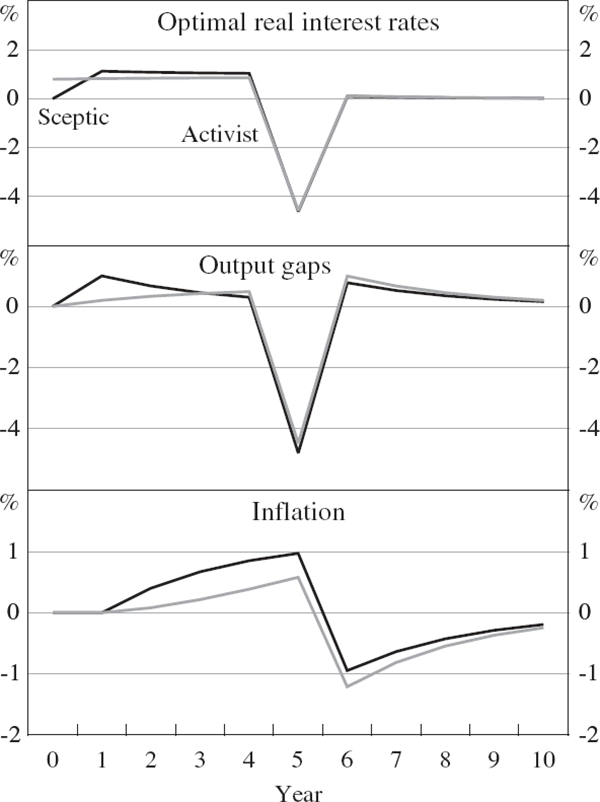RDP 2003-11: How Should Monetary Policy Respond to Asset-Price Bubbles? Appendix A: Policy Settings for a Bubble that Bursts in the Fifth Year
November 2003
- Download the Paper 192KB
We assume a constant probability pt = 0.2 that the bubble bursts in each year. In contrast to the simulations reported in the text, we allow both the sceptic and the activist to implement policy through time – so that the state of the economy depends on the identity of the policy-maker. Figure A1 shows results assuming that, as events turn out, the bubble grows for four years, during which time it has a direct expansionary effect on output of γ = 1 per cent in each year, and then bursts in the fifth year, with a direct contractionary effect on output of 4 per cent in that year.[19] The top panel shows the real interest rate profiles, rt, set by the two policy-makers; the middle and bottom panels show the outcomes for the output gap, yt, and the inflation rate, πt.

Notes: Bubble's ex ante probability of bursting in each year is pt = 0.2. Real interest rates are deviations from neutral; inflation rates are deviations from target.
While the bubble is growing, the paths for output and inflation generated by the sceptic's policy settings reflect the continued expansionary effects of the bubble. The activist responds more aggressively to these expansionary effects because she anticipates them, but nevertheless she does not offset them completely because of the possibility that the bubble may be about to burst. Therefore, even with the activist's optimal policy settings, output and inflation remain above target while the bubble survives.
The bursting of the bubble in year 5 generates a severe recession. Output falls by more than the direct contractionary effect of the bubble bursting, because policy in the previous year has been tighter than neutral to offset the bubble's expansionary effects. In response to the bubble's collapse, policy is eased aggressively. Despite using the same policy rule after the bubble bursts, the modified Taylor rule, Equation (7), the paths for the policy interest rate, output, and inflation are somewhat different for the two policy-makers because they have set different policy interest rates in earlier years.
Footnote
A bubble with a probability of bursting each year of pt = 0.2 bursts on average in the fifth year. [19]